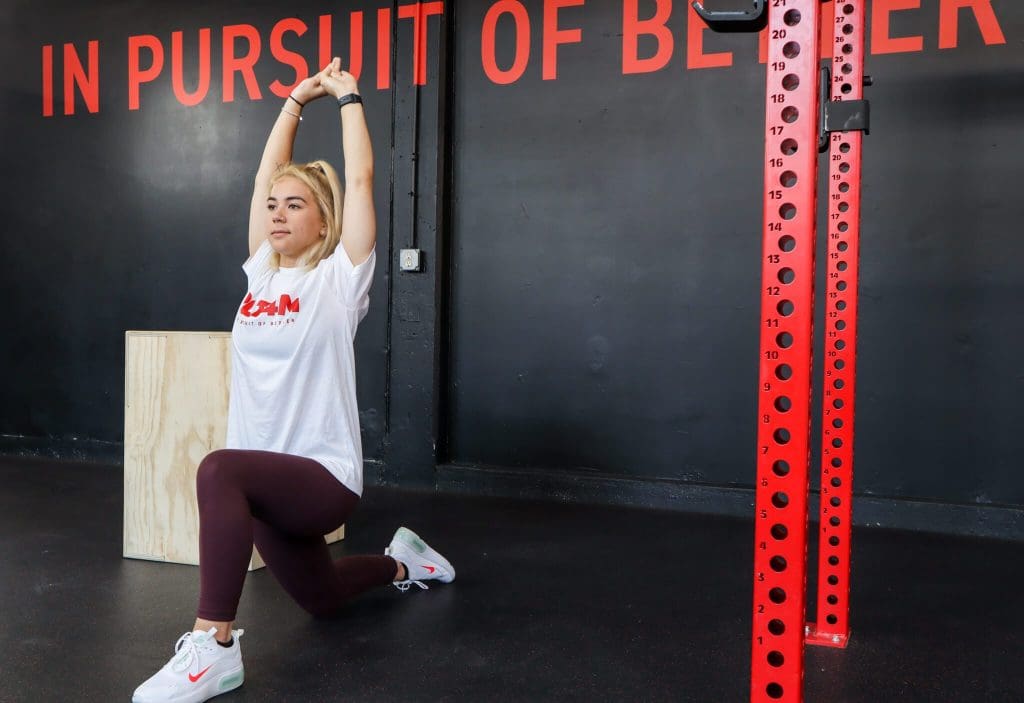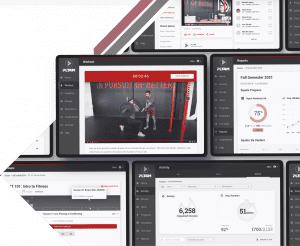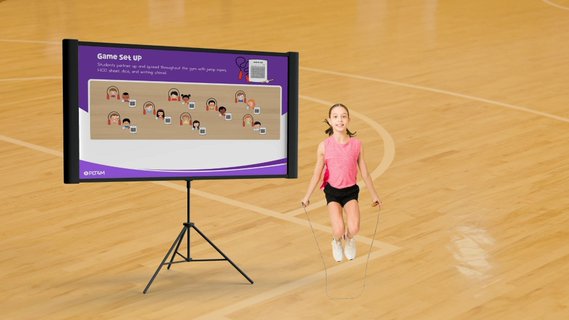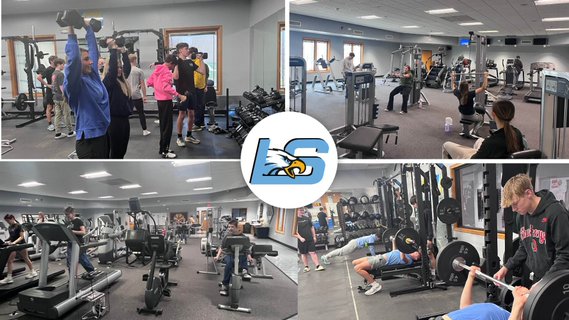As more schools shift from a games to fitness model in physical education, let’s take a high-level look at fitness workouts for high school students. In this article, we explore what fitness really means in high schools and then take a closer look at five different workout examples that students could choose from!
What is Personal Fitness In High School?
Personal fitness as a concept is the total approach to health and wellness. This approach considers the many factors of fitness, including cardiovascular fitness, muscular strength and endurance, flexibility, mental health, nutrition, and more.
Many schools offer a personal fitness high school class that uses lessons and curriculum to address these concepts. At one school in Iowa, PE teacher Josh Van Kampen has shaped his 9th grade PE class to fit the theme of personal fitness,
“I want students to experience different aspects of personal fitness. They don’t have to love everything we do in class, but they can at least understand why it is important or relevant to our theme of personal fitness.”
(Check out the full article on Josh’s Personal Fitness class here.)
And while Josh uses the 9th grade PE course as a stepping stone for personal fitness, this theme is not limited to just one class. Instead, personal fitness is achieved and promoted throughout the whole school.
And this is the case in many schools across the country. Personal fitness is emphasized throughout before and after school workouts, and in physical education classes – making it a school-wide approach.
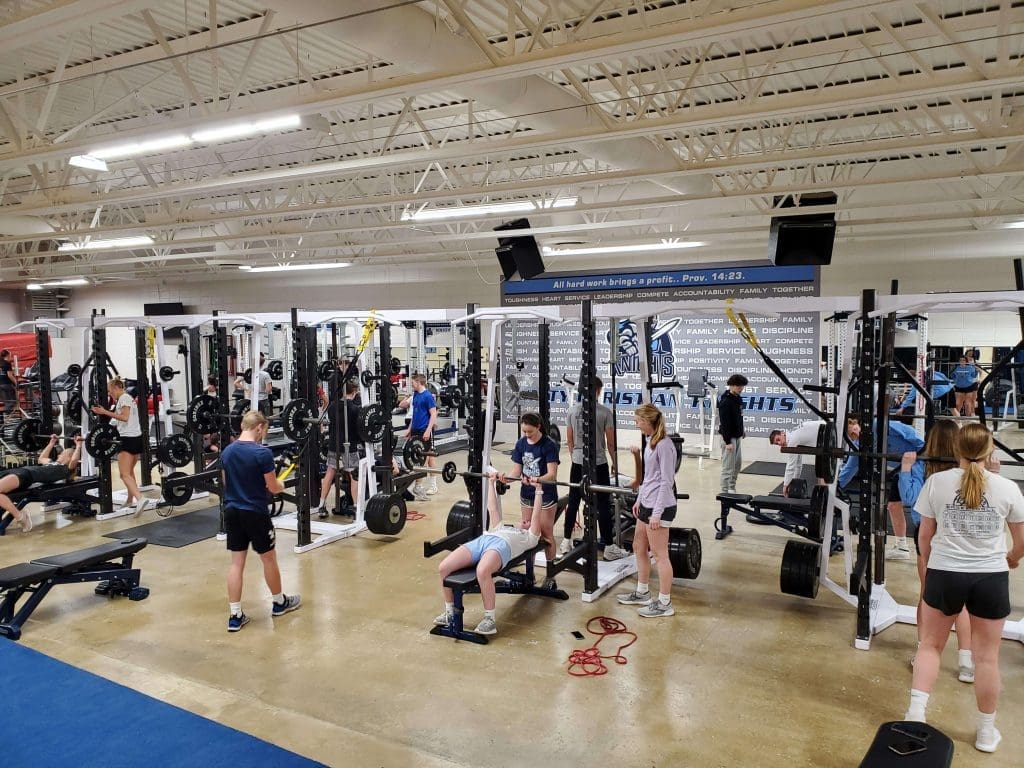
Defining Fitness Workouts For High School Students
At PLT4M, we look at fitness workouts as any activity that will promote life-long workout habits. Most notably, a high school workout plan does not have to be a one-size-fits-all approach.
For some students, fitness workouts can consist of yoga, pilates, dance, boxing, and other typical ‘class-style’ offerings. These are all workouts that students will see at local gyms and fitness centers far past their high school experience.
For other students, fitness in high school is centered around sports. In this case, many student-athletes tap into their high school strength and conditioning programs. Strength training for high school athletes equips them with the skills they can use far past high school when their athletic careers are over.
And because the overarching goal is for students to have a wide variety of fitness options to choose from past high school, many schools choose to expose all students to a combination of the different options. This means student-athletes are given a chance to experience workouts like yoga, pilates, dance, and boxing. And in turn, non-athletes are encouraged to try out different variations of a high school weight lifting program.
Regardless of the track they take in high school; the overall goal is that students are introduced to a variety of fitness workouts that they can continue to do past high school.
Bonus Content! Check out PLT4M’s curriculum and content at a high level!
The Transformation of The High School Weight Room
The typical high school weight room has transformed over the last few years to better fit and accommodate the complete fitness experience for all students.
Historically, the high school weight room has been for high school weight training. And the typical high school weightlifting program mainly consisted of football players.
But as more schools have embraced weightlifting for all students and looked to incorporate other training options, the weight room has become more and more of a fitness center. And although the title of the space may seem a bit of semantics, in creating a more fitness center style approach, all students are getting fitness workouts in throughout the day.
At Riley County High School in Kansas, the school was able to update its weight room and took the approach of inclusivity. Longtime PE teacher Steve Wagner describes the new space,
“We were so excited about our new space. And we wanted it to feel like a place for everyone. We wanted a place where our athletes could work to take their talents to the next level. But, we also wanted an inclusive environment where all students felt like they could improve their fitness level.”
(Check out the full article on Riley County High School)
With this approach, high school fitness centers and weight rooms across the country are a space that opens the doors to all students. And all students are leaving with a variety of different skills from fitness workouts.
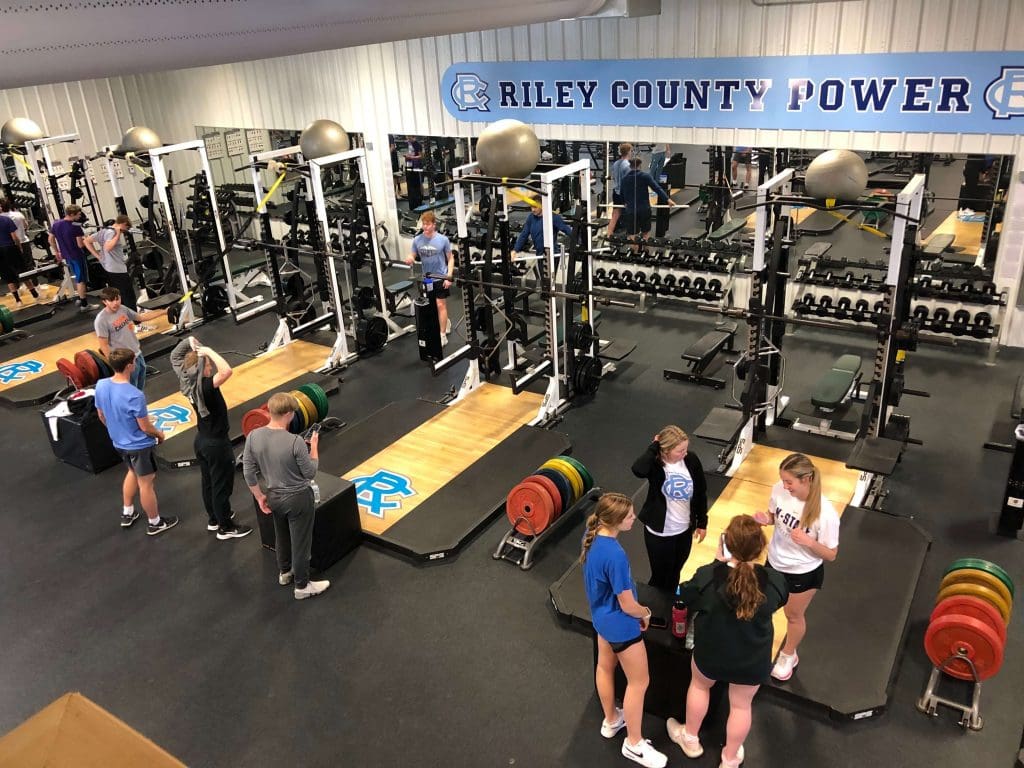
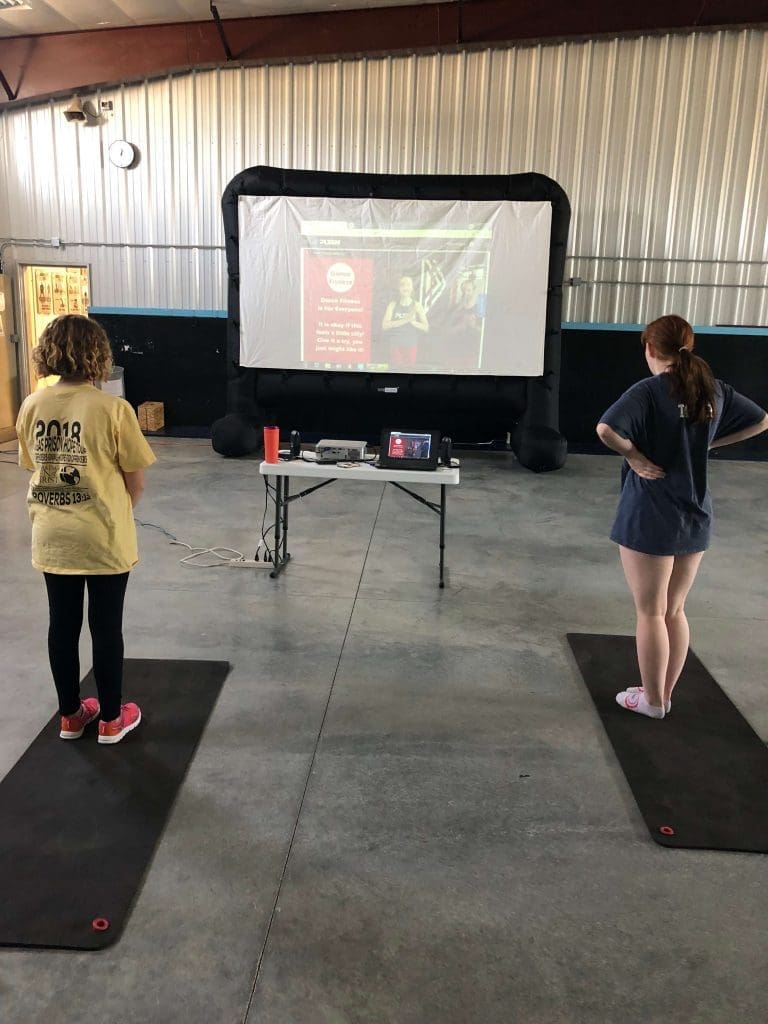
Pictured above is the main high school weight room and the attached auxiliary room where students can try out all types of fitness workouts.
5 High School Workouts To Sample
At PLT4M, there is no shortage of awesome fitness workouts to choose from. The list of different options ranges from:
Let’s look at five different fitness workouts that students do at school and at home with PLT4M.
1) Personal Fitness
Even PLT4M has a program called personal fitness! The perfect program for students and athletes that are serious about their fitness, but don’t desire to throw around barbells or heavy weights every day (or do not have regular access to such equipment). While “strength” will absolutely be worked on, the emphasis here is on movement, work capacity, and conditioning.
Every session begins with a guided dynamic warm-up with position-specific mobility, followed by in-depth movement prep. Many days will include accessory work aimed at strength development and injury prevention as well. Then, the bulk of our training time is dedicated to the daily “Finisher.”
Begin with 2 minutes of light, but continuous aerobic activity (walk/jog/bike/etc).
Then, perform the continuous dynamic hip progression. 10 Yards each of:
1. Traveling Spiderman
2. Hurdle Walk Forward
3. Hurdle Walk Backward
4. Crab Walks (Each Side)
5. Duck Walk
30 Second Hold Of:
2 x 5 Light Reps
Let’s warm up the kettle bell swing (or DB Swing).
Remember, our focus is on maintaining a neutral spine by engaging the core throughout the swing. No rounding of the back, this is a hinge. The hinge should NOT be extreme, either. Think about using the hips to “jump” the weight upward rather than big arc-ing swings.
Pick a light weight that you think you could swing 20 times in a row no problem when fresh. We have suggested a weight below, but use your judgement.
2 x 5 Rep Warm Up
Let’s dial in our core movement for the workout, the reverse crunch. This needs to be about STRICT control, not swinging the legs wildly around.
“Recess”
AMRAP 12:
1:00 Any Light Cardio (Run, Rope, Bike Etc)
10 Reverse Crunches
10 KB/DB Swings
12 minutes of continuous “aerobic” work combining movement patterns.
Swings should be on the light-moderate side, but unbroken and “snappy”. Rest of the work should be slow and steady.
Don’t rush – but never stop, either.
Record the total number of crunches and swings you complete.
If time allows, get some proactive recovery done through a small cool-down session.
Couple minutes of super easy cardio (bike/elliptical is great), then some static stretching or foam rolling.
Trust us when we say taking 5 minutes to get this done will add up over time much to your benefit!
2) Boxing
In these workouts, you will get an introduction to the basics of boxing and get a great workout in the process. Consider it a perfect 1-2 punch!
Each workout will follow the same format as a typical boxing match. That means we will have 8 rounds that consist of 3 minutes of work. You will have a minute of rest between each round to shake it out, grab some water, and get ready for the next round.
Welcome back to lesson 2 of Intro To Boxing! In our first workout, we covered the basics of footwork.
Today, we will continue to grow our skills and learn about boxing offense. The movements we will cover are:
1) Jab 2) Cross 3) Lead Hook 4) Rear Hook 5) Lead Uppercut 6) Rear Uppercut
As we go through today’s workout, be aware of your body and positioning. While we are doing all of these movements without equipment and it can be easy to get sloppy, hammer home your technique so if you ever do go to use equipment like a bag you are ready to go! Like the last lesson, our workout will consist of 8 rounds of 3 minutes of work and 1-minute rest.
A friendly reminder: When Sean moves, you move! Mirror his moves as he takes you through this full workout. Sometimes, during the circuit work, he will stop and coach you, but keep moving as he encourages you through the workout!
Ready to Learn More?
Schedule a free 10 minute consultation to see how PLT4M can help save you time and empower student learning!
3) Yoga
This program is all about the flow! In our Intro to Yoga series, we introduced the basic foundations of yoga and slowly moved through basic flows. Now with a strong foundation, students will dive into more comprehensive yoga workouts that consists of demanding breath to movement flows.
Follow along with today’s flow! If you want to take a look at the flow format and different parts you can check out Coach Lulu’s lesson notes below!
Integration:
**Childs, table top, down dog, rag doll, standing
Sun A: 1x Slow, 1x Fast
**Mountain, side stretch R, mountain, side stretch L, mountain, forward fold, ½ lift. High plank, chaturanga, up dog, down dog
Sun B: 1x Slow, 1x Fast
**Mountain, chair plane, 1 leg mountain, standing figure 4 variation, [place lifted ankle across standing thigh. Bring hands to chest.], 1 leg mountain, crescent plane
**Crescent lunge, low lunge, standing L [New: lift back foot off the mat, engage your glute and hamstring to bring your heal to the ceiling. Straighten through your front leg, as much as feels comfortable. Ground down through both palms], low lunge, high plank, chaturanga, up dog down dog
Sun B+: 1x
**Chair, Chair plane, 1 leg mountain, standing figure 4 [begin to add slight bend in front knee. Press tailbone down towards your mat], 1 leg mountain, airplane pose, crescent lunge, low lunge, standing L, 3x leg lifts [tap lifted toes on your mat, inhale lift, exhale lower] low lunge, high plank, chaturanga, up dog, down dog
Balancing Flow: 1x
**Chair -> Eagle [R/L]
**Mountain -> Dancer [R/L]
**Mountain -> Tree [R/L]
Surrender Flow: 1x
**Seated forward fold
**Supta baddah konasana
**Supine cow face pose
4) Dance Fitness
Let’s turn up the music and have some fun! This program aims to provide every student an engaging and welcoming introduction to the basics of dance fitness. We seek to introduce this form of cardio and dance fitness through a fully-developed lesson plan that allows students to learn new dance moves while getting their heart rates up and smiling!
Today’s lesson we will warmup, learn our 8 new moves, hit a full cardio effort, and then cool down. We have built in some breaks for you to grab water and bring your heart rate back down! Take the breaks!
Our 8 moves are:
Move 1: Heel Toe Taps
Move 2: Step Touch
Move 3: March, Jack, & Slide
Move 4: Step, Clap, & Rope
Move 5: Shimmy Hops
Move 6: Slams
Move 7: T Hops
Move 8: Jump & Jack
5) Pilates
Pilates is a low-impact form of exercise that is a great full-body workout. Pilates focuses on control while enhancing balance, flexibility, and the mind-body connection. This introductory program provides an excellent challenge to all major muscle groups with a special emphasis on the core.
In today’s class, the Pilates exercises include:
1) Hundreds
2) Roll-Up
3) Single Leg Circles
4) Single Leg Stretch
5) Star Pose
6) Side Lying Exercise
7) Seal
8) Push-Ups
9) Rotate & Twist
Hundreds:
Starting on your back, draw your knees into your chest
Lift your head and neck towards your core
Pump your arms 100 times by your side like you are splashing water
Option to extend your legs to make this movement more difficult
Roll-Up:
Starting on your back, legs at a 45-degree angle
Extend your arms keep your shoulders connected to the floor
Curl up with chin to chest and roll up as slowly as possible to sit up tall
Repeat the same motion on the way back down, keeping arms extended
Option to send legs straight to make this movement more challenging
Single-Leg Circles:
Starting on your back, plant your legs to create 45-degree angle
Bring your arms underneath your thigh, and lengthen your leg towards the ceiling
Keep your leg straight, and bring your arms to your sides
Draw a small circle with your toes
Single-Leg Stretch:
Starting on your back, lift your head off the floor
Extend one leg out with a pointed toe, while you draw your opposite knee in towards your chest
Inhale and exhale as you alternate legs on this stretch
Star Stretch:
Starting on your back, hug your knees towards your chest
Extend your arms and legs at the same time like a star
Inhale and exhale as you repeat this motion
The goal is to start elevated and continue to get your arms and legs closer to the mat
Side-Lying Exercise:
Starting on your side, rest your head in your hand and box out your front arm
Lift your top leg so that is floating
Draw your leg forward and back as you flex your foot
Work to keep your ankle on the same level throughout this motion
Seal:
Start sitting up with your legs planted at 45-degree angles
Take your hands in between your legs and grab your ankles as you press into your arms into your thighs
Float your feet up and round your spine
Clap your heals together like a seal and then roll back and up
Push-Ups:
Start standing up, and round down slowly to walk out to a plank position
Stack your shoulders over your wrists, keeping your body in a flat line
Bend your elbows pack and press up
Option to drop to your knees to make this movement easier
Rotate & Twist:
Start standing up, raise your arms over your shoulders
Keeping your hips centered, twist your upper body around down to the same ankle
From here rotate around to the opposite ankle and come back to the starting position
Option to go slow or fast with this progression
T & Heel Lifts
Start standing up, reach your arms out with palms facing down
Come to the balls of your feet like a ballerina and lower back down
Want Hundreds Of Lessons Like This?
Schedule a 15-Minute demo to learn how PE teachers are ushering in a new age of Physical Education with Fitness and Technology!
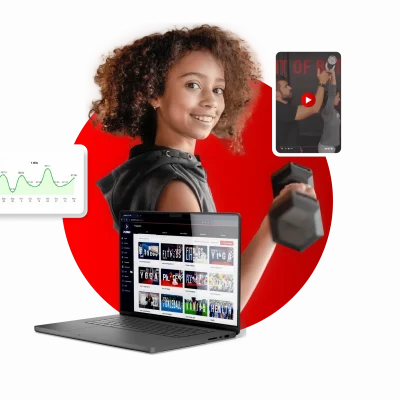
Key Takeaways on Fitness Workouts for High School Students
Physical activity for high school students is crucial. As most students spend most of their day sitting behind desks, schools need to prioritize personal fitness.
High schoolers will benefit from fitness workouts and perform better in all aspects of school. But, more importantly, we will empower teens with skills that they can take with them far past high school for the rest of their lives.
Fitness workouts are the first step in lifelong personal fitness. Give your students choices and options so that they can learn to love lifelong fitness.
FAQ
Does PLT4M have workouts for middle schoolers?
Yes, PLT4M has a wide array of options for middle school workouts. PE lesson plans for middle school students are age appropriate and engaging! There is something for everyone within PLT4M!
The earlier students start to see the importance of exercise and physical activity, the more hope we can have for a generation of students that enjoy and understand the importance of exercise.
